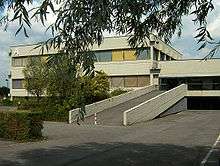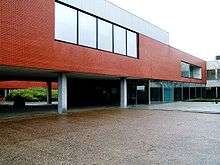Katholieke Universiteit Leuven Kulak
The Katholieke Universiteit Leuven associatie Kortrijk (Catholic University of Leuven Campus Kortrijk), or short Kulak is a university satellite campus of the KU Leuven in the city of Kortrijk (Courtrai) in the Belgian province of West-Flanders and therefore also is officially a Dutch-speaking institution.
Katholieke Universiteit Leuven Kulak | |
| Type | Independent/Partly state funded |
|---|---|
| Established | 1964 |
| Rector | Piet Desmet (campus rector) |
Administrative staff | 150 |
| Students | 1479[1] (2016) |
| Location | , |
| Affiliations | Coimbra Group LERU |
| Website | www.kuleuven-kulak.be |
Background
As the name implies, it is a university campus affiliated with the Katholieke Universiteit Leuven situated on the southern rim of Kortrijk. The idea behind this campus 50 years ago was twofold, but was embedded in the general movement for more democratisation of the higher education. First of all, Leuven always had a strong portion of its students coming from the West-Flanders region. Yet, many prospective students were wary of moving to Brabant for an adventure that would involve an almost complete rupture with their familiar surroundings. (The area is also known for its student bars, which may cause trepidation in parents). Secondly, the majority of students who quit university do so in their first year. Typically, depending on the studies, the first two years (which give a general but thorough introduction into the whole scope of the subject) draw two to three times as many students as the last three or four (in which the student specializes in one specific field of his subject).
By giving their West-Flemish students the possibility to complete their first two to three years in Kortrijk, the Katholieke Universiteit Leuven (KU Leuven) offers them a smaller, easier to manage environment, where teaching is done in smaller groups allowing closer interaction with academic staff. Leuven also benefits as more students in Kortrijk means lesser students in the chronically overcrowded first year lectures in Leuven. Students that have completed the first two to three bachelor years will still move to Leuven (or to any other university, for that matter) to specialize further in their master years but by then they will be more mature, confident and up to the challenge.
All Kulak campus faculty buildings, research facilities, student dormitories, restaurant and social areas are within a single university park, allowing for a true campus life. located on a shallow hill in the "t'Hoge" (the heights) region just south of the city centre of Kortrijk. About half of the students live either in the university dormitory or in a rented room nearby. The other half lives with their family in the greater Kortrijk region, close enough to commute (even by bike) to the university.
History
Beginning
The first academic year started at the KULAK in 1965. Initially, the courses took place in het 'Vormingsinstituut' for SME's, located at the Hoog-Kortrijk area. The first student administration centre was situated in the King Albert Street, in the city centre of Kortrijk. Later, the 'Guesthouse', known as a meeting and lodgingplace for foreign researchers and guest professors, was opened.
Courses
From the founding of the university campus till now, the diversity of programmes offered has been steadily increasing. In 1965, the Kulak started with "Arts and Philosophy" ('Letteren en Wijsbegeerte') (including Law). Six years later, in 1971, the "Medical faculty" and the "Science Faculty" (including Mathematics, Physics and Chemistry) were founded. From 1984 onwards, students could enroll in the "Informatics" (ITC) programme, from 1985 in the "Pharmacy" courses and from 1986 in the "Biology" and "Bio-Engineering" courses. In the academic year 1991-1992, the "Economics" department started ('Toegepaste Economische Wetenschappen'), and from 2004 onwards the "Education Studies" programme is offered.
Building Phases
In 1970, the StuHu was built: a student home containing a restaurant, a meeting room and several living units. In 1971, the 'Groene Mote' (or the 'dorm') was finished. That same year, the faculty or Arts and Philosophy was opened (currently Building A). Building E, housing the Medical faculty and the Interdisciplinary Research Centrum (IRC) was inaugurated in 1973 and 1975.
In 1982, a new expansion phase started which comprised the building of a 'student village', of a new Library and of the Faculty of Science and administration buildings.
In the early 1990s, the new Building B, designed by architect Stéphane Beel, was opened.
In 2007 a new enlargement phase started. This phase consisted in the construction of a new student residence, named 'Corona', to house 81 students and a new building, Building C. Also, the long corridor between Buildings A and B, the so-called "Spina", was extended until the Building E. Soon followed by an expansion of the Interdisciplinary Research Facility - Life Sciences.
In 2017 the student residence 'Groene Mote' was closed down and replaced by a new one named 'Spoelberg' offering accommodation for 103 students.
In the same period the buildings on campus, previously hosting the Innovation and Incubation Centre Kortrijk (IICK) were acquired by KU Leuven, and now are an integral part of the campus.
Campus rectors
Throughout the years, the Kortrijk University has known several campus rectors:
- 1971 - 1991: Mgr Guido Maertens
- 1991 - 1992: Frans Van Cauwelaert
- 1992 - 1996: Vic Nachtergaele
- 1996 - 2001: Marcel Joniau
- 2001 - 2009: Piet Vanden Abeele
- 2009 - 2013: Jan Beirlant
- 2013 - 2017: Marc Depaepe
- 2017 - now: Piet Desmet
Faculties
- Faculty of Arts
- History
- leading to History or Political Sciences
- Linguistics and Literature
- leading to Linguistics and Literature or Communication Sciences
- History
- Faculty of Business and Economics
- Applied Economics
- leading to Applied Economics or Business Engineering
- Applied Economics
- Faculty of Law
- Law
- leading to Law or Political Sciences
- Law
- Faculty of Medicine
- Medicine
- Biomedical Sciences
- Faculty of Psychology and Educational Sciences
- Education Studies
- leading to Psychology, Pedagogical Sciences or Educational Studies
- Education Studies
- Science, Engineering and Technology Group
- Mathematics
- leading to a Bachelor of Sciences in Mathematics or a Bachelor of Sciences in Engineering (at Leuven, main campus)
- Informatics
- leading to a Bachelor of Sciences in Informatics
- Physics
- leading to a Bachelor of Sciences in Physics or a Bachelor of Sciences in Engineering (at Leuven, main campus)
- Chemistry
- leading to a Bachelor of Sciences in Chemistry (including an option towards Biochemistry and Biotechnology), a Bachelor of Science in Pharmacy (at Leuven, main campus), or a Bachelor of science in Bio-Engineering (at Leuven, main campus)
- Biology
- leading to a Bachelor of Sciences in Biology (including an option towards Biochemistry and Biotechnology)
- Mathematics
Buildings
The Kortrijk University Campus is located in the 'Etienne Sabbelaan' in the Hoog-Kortrijk area. The campus consists of several buildings, which are all connected by a 120-meter long corridor: the 'Spina'.

- Building A
- Welcome Desk
- Student Administration
- Central hal
- Faculty of Arts
- Faculty of Law
- Faculty of Psychology and Educational Sciences
- Faculty of Science
- Campus Library
- Rectorat

- Building B
- Faculty Business and Economics
- Postacademic Education (PAV)
- Building C
- Faculty Educational Science (Onderwijskunde)
- Building E
- Faculty of Medicine & Biomedical Sciences
- Interdisciplinary Research Facility - Life Sciences
- Incubation and Innovation Centre Kortrijk (IICK)
- Students centre
- Student House with restaurant, bar and social event area
- Faculty Club restaurant
Student Dormitories
- De Groene Mote (closed)
- Students Village
- Corona
- Spoelberg
Trivia
The Kortrijk University houses the "Library of the French Netherlands (French: Pays-Bas français; Dutch: Franse Nederlanden)",[2] containing a collection regarding the literature and history of the French Netherlands, and an "Archive French Netherlands" containing documents about the regionalist movements in Northern France.[3]
External links
Notes and references
- KU Leuven student numbers 2015-2016
- Streek Verbond Vlaanderen-Artesië-Henegouwen : Voor de Franse-Nederlanden
- De Franse Nederlanden Archived 2010-02-04 at the Wayback Machine, bibliotheek KULAK